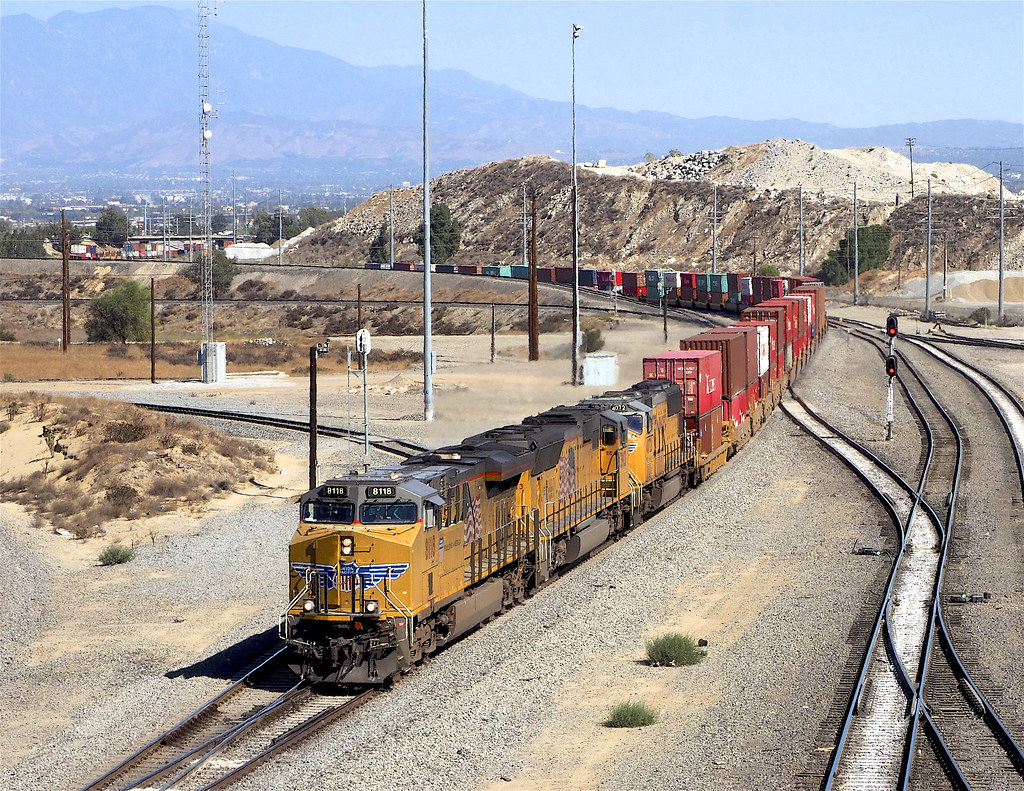
Colton Crossing, located in Colton, California, is a historic rail junction where the Union Pacific and BNSF Railway lines intersect. Known for its heavy train traffic, it offers a prime spot for train enthusiasts to observe a variety of freight trains. The crossing was reconfigured in 2013 to improve efficiency.
Photos
Sign in to upload photos
No Photos Yet
Be the first to share photos of this location!
Colton (Colton Crossing) – Colton, California, USA | Train Spotting Location
Trainspotting Experience
A typical visit rewards you with near-constant movement: westbounds grinding toward Los Angeles ports, eastbounds accelerating for the Cajon and Beaumont Passes, and the unmistakable throb of distributed-power locomotives pushing from the rear. Railfans usually set up along South Rancho Avenue or the service road paralleling the BNSF Transcon; from here you can watch Union Pacific trains climb the concrete flyover while BNSF trains slip underneath at grade. Expect thunderous noise as locomotives claw at the slight ruling grade—especially noticeable when heavy manifests stack four or five GE Evolution Series units on the point. Train lengths commonly exceed 8,000 feet, so a single meet can fill ten minutes of continuous action. Radio traffic on AAR channels 36 and 66 crackles every few minutes, giving advance warning of movements. Ear protection is wise, and tripods should be weighted because passing consists create notable ground vibration.
Landscape, Setting & Local Atmosphere
Colton sits in the broad San Bernardino Valley at roughly 1,000 ft elevation. The terrain is flat industrial land rimmed by distant mountains: the San Gabriels to the west and the taller San Bernardinos to the northeast, both often snow-capped in winter. Vegetation along the right-of-way is low desert scrub—saltbush, tamarisk, and the occasional palm escaping from nearby yards. Air can be hazy, but morning light is generally crisp thanks to onshore flow from the Pacific. Summers are hot and dry, with afternoon mirages shimmering off the railhead; winters are mild, and clear post-frontal days deliver startling visibility that places Mt. Baldy squarely in your background shots. Despite adjacent warehouses and a steady hum from I-10, the constant click-clack and horn echoes give the spot a rail-centric ambience that drowns out most other urban noise.
Type & Frequency of Train Activity
Railfan counts typically register 80–110 trains per 24-hour cycle. BNSF’s Southern Transcon contributes high-priority intermodal blocks, domestic stack trains, and UPS/Postal hotshots on tight schedules. Unit trains of autos, ethanol, and grain also funnel through. Union Pacific’s Sunset Route sends manifest freight, doublestack intermodal, and occasional military moves over the flyover. Amtrak’s Sunset Limited (tri-weekly) and occasional detoured Pacific Surfliner sets add a passenger cameo, though most passenger traffic uses the parallel Metrolink San Bernardino Line a few miles north. Distributed power is common, and helpers are sometimes cut in mid-train for the upcoming mountain grades. Locomotive variety spans GE ES44C4s, EMD SD70ACe-T4s, and the latest Tier 4 SD70Ms, often in elephant-style lash-ups.
Best Angles for Photos & What Railfans Enjoy Most
• East Side Embankment: Stand on the public sidewalk along South Rancho Avenue for a three-quarter view of UP trains cresting the flyover with Cajon Pass peaks in the distance. Morning light is nose-lit; late afternoon backlights dust clouds for dramatic silhouettes.
• West Side Dirt Lot: Accessible off Agua Mansa Road, this low-level angle places BNSF power framed beneath the curving flyover—ideal for illustrating the grade separation.
• Ninth Street Bridge: A safe pedestrian walkway lets you shoot straight down onto the diamond remnants and capture simultaneous movements on both railroads. Overhead shots here emphasize train length snaking through crossovers.
Photographers should bring lenses from 24 mm wide-angle to 300 mm telephoto. Tripod collars help track long consists, and polarizers tame midday glare off locomotive paint. Best light occurs October through March when the sun stays lower and snow caps the northern ridges.
Historical or Cultural Relevance
Completed in 1883, the original at-grade diamond quickly became a chokepoint for transcontinental traffic, earning a reputation as California’s busiest railroad intersection. For 130 years it was also a railfan rite of passage—the place where steam from Santa Fe 3751 once met Southern Pacific cab-forwards. In 2013, a $93-million public-private project replaced the diamond with a 1.4-mile flyover, lifting Union Pacific above BNSF and eliminating up to 15 hours of daily freight delays. Interpretive plaques near the northwest corner recount the engineering feat and display artifacts such as a retired signal mast that governed the old crossing. Local civic pride remains strong; Colton’s city seal still features crossed rails commemorating the junction’s role in regional development.
What Makes This Spot Different
Unlike mountain passes where trains are spaced by capacity limits, Colton delivers volume—often two, even three trains in the frame at once—and showcases contemporary railroading’s logistical choreography. The juxtaposition of an elevated concrete superstructure over nineteenth-century alignments offers unique compositions impossible at flat diamonds like La Plata or Rochelle. Additionally, Colton provides simultaneous access to both major western Class I carriers without the need to reposition, allowing side-by-side comparisons of paint schemes, motive-power strategy, and dispatching philosophies in real time.
Localisation
Coordonnées :34.066739, -117.343574
Seasonal Information
Colton Crossing in Colton, CA, is ideal for train watching year-round due to its heavy freight traffic. Spring and fall offer mild weather, while summer can be hot. Winter provides cooler temperatures. Check schedules for any seasonal changes or special events.
Other Interesting Locations
Looking for more spots? Browse the complete list of train spotting locations.
Quick Information
Country
USA
Region / State / Province
California
City
Colton
Spot Type
Junction
Best Times
Best hours to observe trains at Colton Crossing are during daylight, especially morning (7-9 AM) and evening (5-7 PM) for peak freight activity.
Access & Amenities
Parking
Not available
Shelter
Not available
Restrooms
Not available
